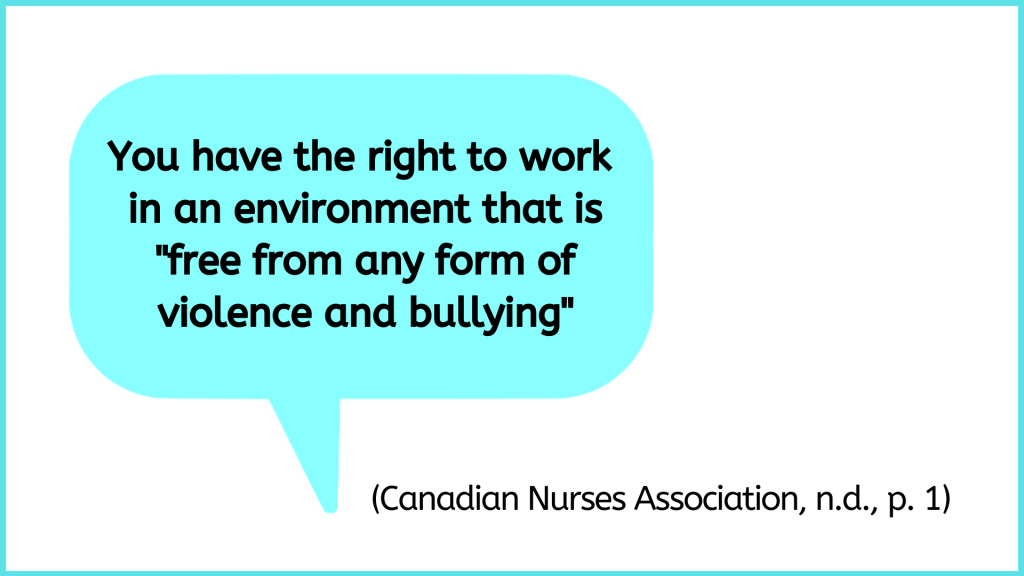Interpersonal Violence
Harassment and Communication
Edited by Jennifer Lapum; Oona St-Amant; Michelle Hughes; and Joy Garmaise-Yee
Effective interprofessional communication and interactions are essential to safe and effective work environments in healthcare. It is important to focus on respect in healthcare settings because of the ubiquitous nature of conflict and the potential for harassment, bullying, and violence.
The terms harassment and bullying are often used interchangeably. By definition, both behaviours are repetitive (happen more than once) and harm or humiliate another person. Harassment can also include one-time incidents of unwanted verbal and/or physical behaviour (Canadian Human Rights Commission, n.d.). These behaviours usually occur in the context of a real or perceived power imbalance. For example, the person who is bullying often thinks they have more power (e.g., more seniority, authority, specialized title/role, more education). They may also occur between nurses as forms of horizontal violence.
Many forms of harassment and bullying can occur within the nursing profession (intraprofessional) and across various healthcare professionals (interprofessional). They may be physical, but most commonly they take the form of verbal harassment, bullying, and aggression. This type of behaviour includes demeaning, humiliating, and belittling language, hurtful teasing/jokes, name-calling, slurs, insults, gender- or racial-based harassment, and criticism as opposed to critique. Non-verbal bullying can include eye-rolling and other facial expressions, ostracism, as well as purposefully not helping colleagues or continually assigning someone workloads that are considered difficult and problematic.
Bullying can be overt or covert. You may not readily recognize that you are being bullied, and not everyone who bullies someone is aware that their behaviour is bullying.
Sometimes these behaviours arise because of interprofessional conflict, but they can also be caused by personal issues. For example, healthcare team members could have stress at home, financial concerns, or anger management issues. All of these factors can affect how they engage with others in all settings, including the healthcare environment – and the stresses associated with the healthcare environment can also be contributing risk factors. Whatever the reason, you have the right to a workplace that is free from any form of harassment. See Figure 3.6.

Figure 3.6: Workplace free from harassment
Professional nursing associations have been instrumental in addressing and managing bullying and harassment in the workplace. It is important for all nurses to attend to this form of violence in the workplace and take a leadership role in order to make change. Nursing has a legacy as an oppressed group because of its history as a subordinated profession (i.e., being considered subservient to the medical community) and because of socio-cultural structures like nursing being deemed gendered work. Oppressed group behavior leads to horizontal violence, when parties in the same group lash out or exhibit violence toward each other in response to external dominant power. In such cases, members of an oppressed group feel subjugated and powerless against a dominant group and essentially take it out on each other. It is important to be aware of this dynamic as we work toward creating workplaces that are free from and intolerant to violence.
Why is it important to understand violence, harassment, and bullying?
Violence, harassment, and bullying are identified as occupational health and safety hazards that are underreported and often unrecognized (Becher & Visovsky, 2012).
As a nursing student, you need to be aware of what harassment and bullying are and how to deal with them. These behaviours are not always conscious choices, so self-reflection and awareness are important first steps toward eliminating violence in the workplace. Being the victim of bullying can have traumatic effects on self-esteem, mental health, and confidence in the workplace. Additionally, systemic bullying within an interprofessional team setting can affect staff morale, job performance, team functioning, and importantly, client care.
What should you do if you observe someone being harassed?
First, if you observe another healthcare professional being harassed or bullied, step in and support the person being harassed or bullied.
Second, if you feel comfortable and safe, have a discussion with the person doing the harassing or bullying. Avoid participating in confrontational dialogue. Engage in an inquisitive discussion to better understand why it is occurring, and, if the person doing the harassing understands what they are doing and its impact on the person being harassed.
Third, if the harassment continues, report and document the incidents to your manager and the human resources department. If it is your manager doing the harassing, human resources should be your main point of contact.
Points of Consideration
What should I do if I am being harassed or bullied?
“I am a nursing student. What should I do if I am being harassed or bullied in my clinical placement or in school?”
First, recognize this is not your fault and you do not deserve this. You have the right to a civil learning environment free of violence, harassment, and bullying. Second, speak with whoever you feel most comfortable talking to. It’s a good idea to speak with a trusted individual within your school or university so that they can provide appropriate resources. If you are a student at Ryerson University, you can contact the Office of Discrimination and Harassment Prevention Services, or the Office of Sexual Violence Support and Education.
Activity: Check Your Understanding
Media Attributions
- Figure 3.6

